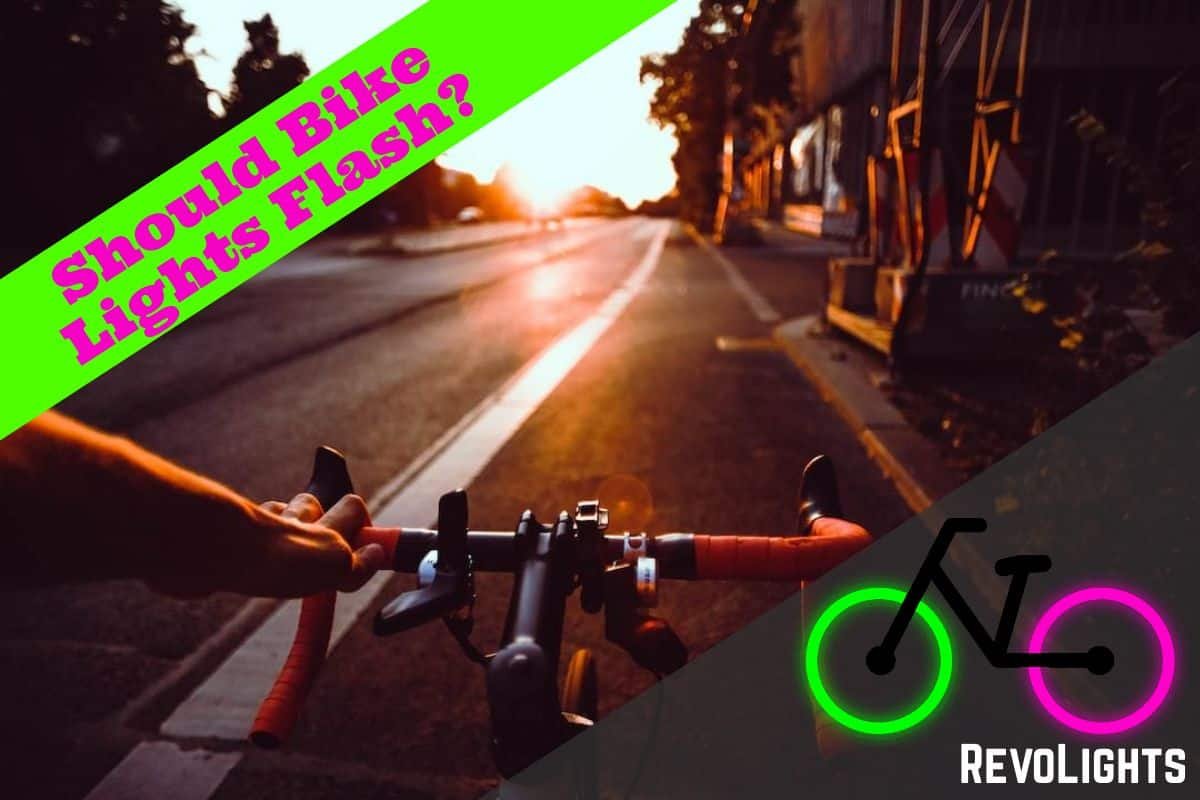While flashing bike lights can alert other bikers and pedestrians in your path, they can also affect vision and cause poor judgment on the road. Some individuals are sensitive to brightness and constant light flashes because they put stress on their eyes. So, should bike lights flash?

Bike lights should flash only when necessary. Read further to determine if they’re legal and when to use them in specific situations.
Solid Versus Flashing Lights
Many lights have multiple settings, ranging from a steady beam to a pulsating flash. Solid white light allows cyclists to see the road ahead during the night hours. They also have a high luminance that affects eyesight even if drivers and bicyclists glance at them for only a second.
Solid lights can also be adequate for drawing attention, making them a poor choice as a rear light or a glaring headlight. The beam can affect individuals with sensitive eyes or a preexisting ocular condition, causing them to lose their vision permanently.
Photoreceptors are usually activated when a bright light reaches the eye lens. Flashes of light start periodically and may trigger retinal issues. The situation is similar to steady rear car lights attracting our attention at first glance.
The Advantages and Disadvantages of Flashing Bike Lights
Flashing bike lights are a common addition to many cycles but have benefits and flaws. However, a specific option must be reasonable after considering the best light.
Advantages
Precaution – When cycling at night, flashing lights can make the cyclist visible and consume less battery power. Cyclists are encouraged to use a steady light to improve the visibility of the path or road ahead if a particular area lacks illumination.
Courtesy – You must be considerate to individuals on the opposite side of your lights, whether facing a pedestrian or a motorist who is going straight. Unfortunately, not everyone considers how lights affect poor eyesight and eye health. You could also receive negative responses if you keep your lights high for long periods.
Visibility – Flashing lights immediately attract attention due to their continuous quick beams that flash at least per millisecond. They can signal your presence in a bike lane or ride down a street with no lamp posts or other lighting sources. Steady lights also help drivers identify you, but they remain fixed on a particular location and illuminate other objects or individuals.
Disadvantages
Obstruction – When a rider passes by in the opposite direction, you can cause momentary blindness on dimly lit streets and dark roads. Drivers can run over potholes and approach obstructions while recovering from the glare of your lights.
Misjudgment – Flashing lights may increase your visibility, but they can also cause a driver to inaccurately judge your speed and distance. Therefore, a cyclist in the opposite lane can collide with a motorist who thinks they have the right-of-way, going straight or turning left at a crossroad.
Regulations – Both steady and flashing lights have specific laws created for cyclists to follow. Not everyone knows what they entail and could violate them unknowingly.
Lighting Issues – Some flashing lights fail to function properly due to defective components. The beam could be unstable, the light may shine harshly, or lumens may highlight a particular area inaccurately.
Why You Must Know How and When to Flash Your Bike Lights
One drawback of flashing lights is their challenging visibility, making it nearly impossible for cars to determine their location and speed. The issue can have tragic results if you ride on a congested dark street. Subtle lighting allows motorists to identify you quickly and avoid hitting you or getting into an accident.
Consider using a steady light during night hours because the beam is less likely to confuse motorists and bicyclists. Also, ensure your light is a minimum of 300 lumens for clear visibility in the evening and during the dawn. The beam shouldn’t cause disorientation or impair a driver’s vision.
Verify the direction of your lights to ensure they face the location you intend to go. The preventive method prevents drivers and other riders from staring directly at the beam. It can also reduce the risk of a collision.
Some lights emit up to 3000 lumens of intensity, which can easily impair visibility. As a safety measure, you may want to consider positioning each light at a downward slant or slight tilt. The method can give you a clear view of the road without obstructing the vision of bicyclists, pedestrians, and drivers.
How to Avoid Affecting Other Individuals with Your Bike Lights
Whether you choose a steady or flashing light, the final decision is up to you. It would be best to remember the advantages and flaws of specific lights, which can be beneficial or costly, depending on the situation. Rear lights with lower intensity or less severe flash patterns can minimize the risk to individuals with sensitive eyes.
A flashing rear light is a reasonable choice to attract the attention of other road users. Steady and flashing rear lights could also allow motorists and pedestrians to detect your distance and speed. You must determine how one light functions compared to the other because not all are reliable.
You can consider choosing a light with various settings that allow you to control its intensity. Some lights have smart technology controllable using an app available by the manufacturer. You can dim or brighten the beam to a setting that allows other bicyclists to identify you.
Also, you can maintain efficient visibility with fewer lumens that are safe for individuals who experience painful effects due to brightness. Many new bike lights are AI-compliant and have advanced features.
Steady bike lights are standard among many bike riders who prefer to ride during night hours. Other individuals want an alternative to fixed beams but are uncertain if they should add lighting that flashes consistently. Therefore, you can rely on information about both lighting types, especially when asking yourself, “Should bike lights flash?” while riding in the dark.

